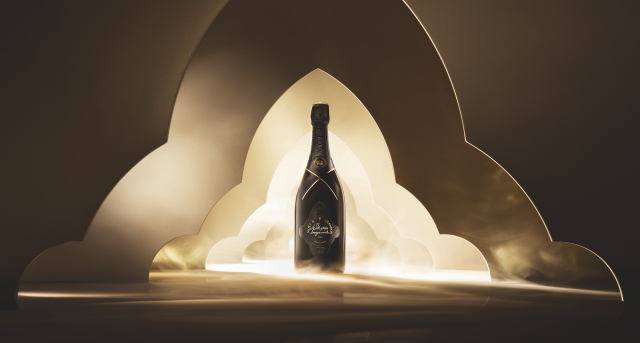This website uses cookies so that we can provide you with the best user experience possible. Cookie information is stored in your browser and performs functions such as recognising you when you return to our website and helping our team to understand which sections of the website you find most interesting and useful.
Why Moët’s new top-end Champagne is ‘haute oenologie’
At a preview of Moët & Chandon’s latest top-end Champagne, db learnt a new term for the winemaking that goes into it – ‘haute oenologie’.

Explaining the approach to Moët’s different Champagnes, chef de cave Benoït Gouez used this description when introducing the producer’s prestige cuvée, which is called Collection Impériale, and comes with a retail price of more than £200.
Speaking ahead of the new expression’s official launch – which was earlier this month – Gouez told a handful of UK press in London in June that the Champagne “is the ultimate of what we can craft with the knowledge we have today,” calling the method “haute oenologie”.
For Gouez that means not only a high-end Champagne, but also one that represents a series of firsts for the house, making Collection Impériale a type of test-bed for what is achievable at Moët.
Among such pioneering oenological moves employed for the new cuvée is both the nature of the wines’ ageing and the character of the dosage.
Not only is this Moet’s first fizz to employ oak-aged wine from five different vintages, but it is also the brand’s inaugural sugarless Champagne – Collection Impériale is a brut nature.
Furthermore, the blend incorporates a small proportion of reserve wine that has been aged in bottle, rather than cask, ensuring that this Champagne contains a host of different approaches.
Indeed, the just-released expression employs wine that has been aged in oak; in bottle on its lees, as well as in stainless steel – with the latter material used for the base vintage, which is the 2013 harvest.
In total, seven vintages have been used to craft Collection Impériale, which has been dubbed Création No. 1, as it is the first expression in a series of 10, with the subsequent expressions due to be released every couple of years from now until 2043 – which is Moët & Chandon’s 300th anniversary (the house was founded in 1743).
Describing this year – Moet’s 280th – as the start of a “countdown” until 2043, Gouez said that Collection Impériale was “a tribute to our founder”, and “the ultimate expression to date, with all our know-how”.
Continuing, he said that “It is possible today because we have the experience of blending Impérial and the experience of selecting vintage,” referring to the brand’s two main expressions: its Brut NV and single-harvest Champagne, called Grand Vintage.
As reported by db at the start of October, Collection Impériale Création No. 1 is a blend of seven different vintages with the base one being the 2013 harvest aged in stainless steel tanks, which accounts for 42.5% of the cuvée.
Speaking about this harvest in particular, Gouez recalled how 2013 was the only time in his 25 years of working at Moët when picking “happened in October”, with harvesting for the other vintages this century taking place in August and September.
This ensured that in 2013, the grapes ripened during a month when light levels and temperatures were relatively low, producing a wine which was “fresh and vibrant”, and, as a result, Gouez said that the vintage was “atypical for the modern era of Champagne.”
Added to the wines from 2013 are five older vintages (’12, ’10, ’08, ’06, ’00) that have all been aged in 50hl oak casks. Together, these make up another 42.5% of the blend.
The wine is then topped up with 15% of the 2004 vintage aged in bottle on its lees after the prise de mousse (which is the secondary fermentation in Champagne).
Gouez stressed that the ageing of the wines in oak was “more about texture,” commenting that the material brings “sucrosity on the palate”, before stressing that the casks did not impart any flavours from the wood on the wine.
While he said that the oak-ageing brings a micro-oxygenation to the wine, in contrast, the small proportion of Champagne that ages on its lees in bottles gives “a strong reductive character”.
The final blend – which is 40% Chardonnay, 40% Pinot Noir and 20% Meunier – has been “built layer after layer; it really is a construction”, he said, describing the wine as “dark and deep, with reductive, grilled, roasted characters combined with salinity.”
As for the absence of sugar in the Champagne, Gouez said, “For a long time I’ve been convinced that a dosage is needed, but I picked a version [of Collection Impériale] with no dosage, because I found it to be the truest.”
Nevertheless, he stressed that the sugarless Collection Impériale No. 1 still has a dosage containing “a selection of reserve wines with sulphur dioxide to balance the oxidative trauma of disgorgement.”
As for future editions of this new Moët multi-vintage prestige cuvée, they will be numbered from 2 to 10, and could contain a different number of harvests. He also refused to rule out using some sugar in upcoming releases.
75,000 bottles have been produced of the inaugural Collection Impériale, with the Champagne initially available in the UK, Germany, Italy, Spain and Japan. The UK RRP is £207.
Read more

